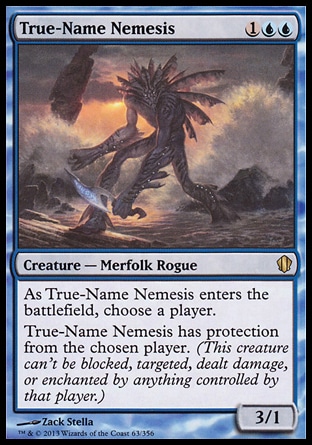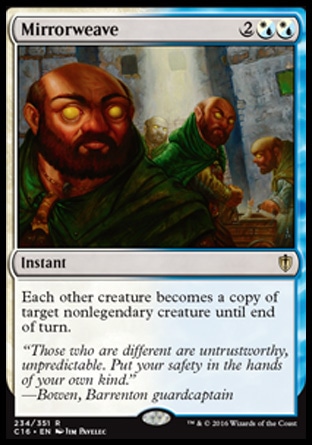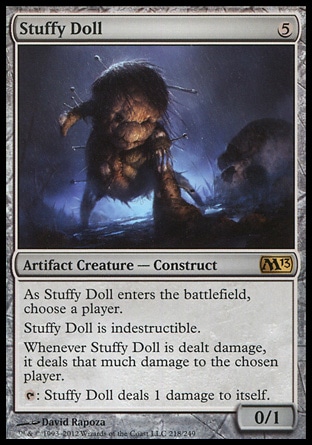New Legacy All-Star True-Name Nemesis introduced a new kind of Protection to Magic — Protection from player. Although there is nothing brand new about this ability, it is still shrouded in a halo of mystery and entombed under a thick layer of the city legends.

Oracle Text:
Creature — Merfolk Rogue
As True-Name Nemesis enters the battlefield, choose a player.
True-Name Nemesis has protection from the chosen player. (This creature can’t be blocked, targeted, dealt damage, or enchanted by anything controlled by that player.)
First, a few general words about True-Name Nemesis before we take another look at the Protection ability. The Merfolk guy has two abilities, both are static.
The first ability generates a replacement effect and is applied when True-Name Nemesis enters the battlefield. It doesn’t go on the stack, is not controlled by any player and doesn’t target the chosen player. This means that Leyline of Sanctity, for instance, can’t save from it.
The second ability grants True-Name Nemesis Protection from the player chosen for its first ability.
702.16j “Protection from [a player]” is a variant of the protection ability. A permanent with protection from a specific player has protection from each object the player controls and protection from each object the player owns not controlled by another player, regardless of that object’s characteristic values. Such
- a permanent can’t be targeted by spells or abilities the player controls,
- enchanted by Auras the player controls, equipped by Equipment the player controls, fortified by Fortifications the player controls,
- or blocked by creatures the player controls,
- and all damage that would be dealt to it by sources controlled by the player or owned by the player but not controlled by another player is prevented.
Why are there so many words? This is because only permanents, objects on the stack and emblems in the command zone have a controller. All other objects such as cards in the graveyard only have an “owner”.
Also cunning opponents sometimes steal other player’s objects under their control. This is when it is important who controls the object rather than who owns it.
True-Name Nemesis’s abilities are so-called linked abilities. In an ordinary game there is nothing complex about it. You choose the player with the first ability and refer to the chosen player in the other ability’s text. The fun part starts when along with one pair of linked abilities the object gains another pair. If this happens the abilities continue working in pairs and ignore the other pair even if they are applicable somehow.



Now 10 ways of dealing with True-Name Nemesis
1. Counter True-Name Nemesis spell.
True-Name Nemesis’s second ability and thus its Protection only work when the Merfolk is on the battlefield. Nothing can normally prevent you from countering its spell: Cancel, Force of Will , Cryptic Command.
2. An effect that exiles or destroys permanents without targeting them.
Wrath of God, Day of Judgment, Void, Nevinyrral’s Disk and Final Judgment.
3. An effect that destroys or exiles permanents and targets something else.
This is tricky. you may target another object named True-Name Nemesis that doesn’t have Protection from you with something like Maelstrom Pulse or Detention Sphere.
4. An ability or a spell that deals unpreventable damage.
If the damage cannot be prevented, Protection won’t save True-Name Nemesis due to the Magic Golden rule #2, and True-Name Nemesis will die the next time SBA are performed: Leyline of Punishment + Pyroclasm.
5. A spell or an ability that doesn’t target and reduces the toughness of creatures to 0 or less.
Reduction of the toughness is not damage and cannot be prevented by Protection. Toxic Deluge, Night of Souls’ Betrayal.
6. A spell or an ability that doesn’t target and puts -1/-1, -2/-1 or other such counters.
Counters are not damage: Black Sun’s Zenith.
7. Effects that tell True-Name Nemesis’s controller to sacrifice a creature.
If a spell or an ability targets a player or doesn’t target anything at all, Protection won’t help: Liliana of the Veil, Fleshbag Marauder, Innocent Blood.
8. Redirect a spell that can legally target True-Name Nemesis.
If your cunning opponent targets your creature with Lightning Bolt, you may use Redirect to change its target for True-Name Nemesis that has Protection from you. Everything is legal, because you don’t control Lightning Bolt and Redirect doesn’t target True-Name Nemesis.
Note that Commandeer won’t help you here since you gain control of the Lightning Bolt in this case.
9. You may gain control of True-Name Nemesis and sacrifice it.
Tibalt, the Fiend-Blooded ultimate ability allows you to “borrow” True-Name Nemesis and then you may sacrifice it for Tymaret, the Murder King.
10. Turn into a pumpkin and dispose in any way possible.
- ⇑ In casual variants of the game (Planar Magic, Vanguard, Archenemy and Conspiracy Draft) there are additional objects have controller in the command zone.
- ⇑ 101.2. When a rule or effect allows or directs something to happen, and another effect states that it can’t happen, the “can’t” effect takes precedence.
Translated by Witas Spasovski

Let’s imagine that True-Name Nemesis entered the battlefield and its controller has chosen a player. After that True-Name Nemesis became a copy of Stuffy Doll. If this copy now is dealt damage, its triggered ability won’t do anything.
True-Name Nemesis’s dirst ability is linked to its own second ability (the one that grants Protection) and it is not linked to the Doll’s triggered ability. Doll’s triggered ability is linked to its own first ability, and as copy effects don’t copy choices made for the original objects, the player for the triggered ability is unidentified. Although the two abilities do the same thing, they are different. Surprise!